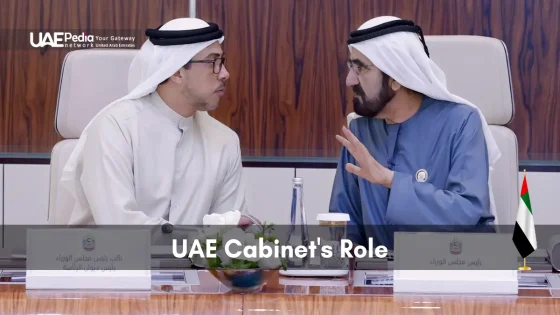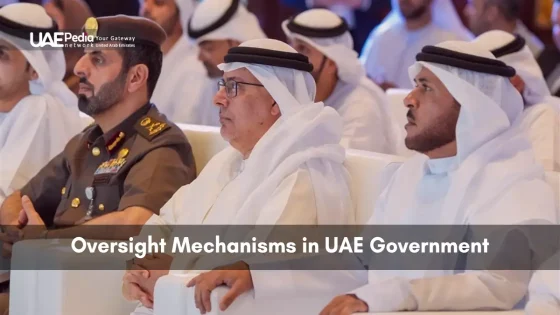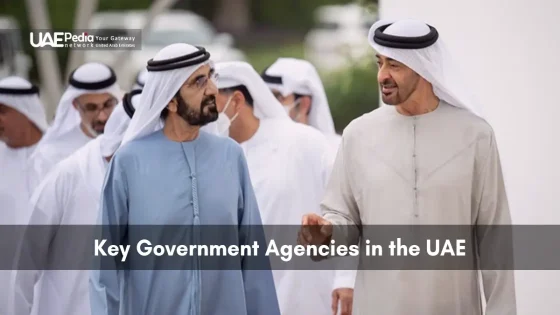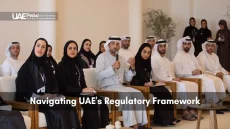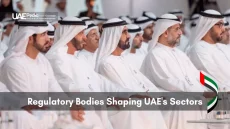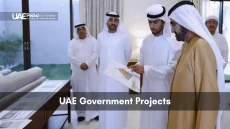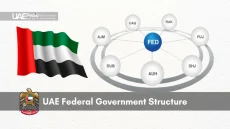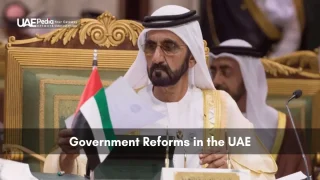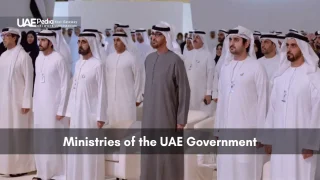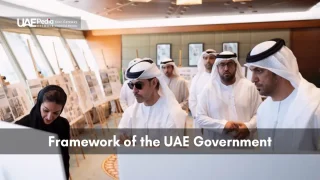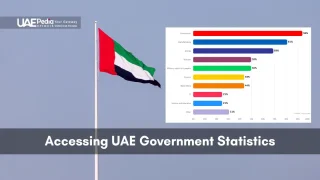In the United Arab Emirates, the Cabinet is key. It’s the top part of the government. It has 37 ministers, with 9 women in important spots. They help guide the country’s future.
But what does the Cabinet do? How does it work in the UAE’s complex government? Let’s explore the Cabinet’s duties and how it runs this important place.
The UAE Cabinet started on December 9, 1971. It’s grown to be a vital part of the country’s leadership. It follows the UAE Constitution and laws. The President and the Federal Supreme Council watch over it, making sure everything runs smoothly.
Historical Development and Formation of the UAE Cabinet
The UAE Cabinet started on December 9, 1971. Sheikh Maktoum bin Rashid Al Maktoum led the first cabinet. Since then, new cabinets were formed in 1973, 1977, and 1979.
Sheikh Rashid bin Saeed Al Maktoum became Prime Minister in 1979.
Current Cabinet Structure and Composition
Now, the UAE Cabinet has 37 ministers. Their jobs and duties are set by the UAE Constitution (Articles 55-67). The Cabinet’s role is key in making policies and laws.
Constitutional Framework and Legal Basis
The UAE Cabinet follows laws on ministers’ pay and benefits. It also follows rules for the General Secretariat. This makes sure the Cabinet works well under the UAE’s laws and Constitution.
| Key Facts about the UAE Cabinet | Data |
|---|---|
| Total Number of Ministers | 37 |
| Cabinet Formation | First Cabinet formed in 1971, subsequent cabinets in 1973, 1977, and 1979 |
| Prime Minister | Sheikh Rashid bin Saeed Al Maktoum (since 1979) |
| Constitutional Articles | Articles 45, 54-67 |
| Federal Laws | Governing ministers’ pay, pensions, retirement benefits, and General Secretariat regulations |
The UAE Cabinet’s history is guided by the Constitution and laws. This strong base helps the Cabinet make important decisions. It plays a big role in shaping the country’s future.
The UAE’s continuous cabinet restructuring since 1971 follows constitutional Article 54 provisions, serving as a model for GCC constitutional monarchies in executive branch modernization Ref.: “Al-Suwaidi, J. & Al-Shamsi, F. (2021). Constitutional Evolution of UAE Executive Authority. Emirates Center for Strategic Studies.”
UAE Cabinet’s Role and Executive Authority
The UAE Cabinet is very important in the country’s government. It makes sure federal policies are followed. It also makes laws, budgets, and rules for public services. The Cabinet checks if laws are followed well. It makes sure the country works together smoothly.
The Cabinet can pick and fire government workers. It also controls how they work. It makes laws, budgets, and oversees policies in all emirates. The Cabinet also makes sure court decisions are followed. It deals with international agreements. This makes it a key part of the UAE’s government.
Through its work, the Cabinet helps the country grow. It makes sure the government works well together.
| Key Functions of the UAE Cabinet |
|---|
| Implementing federal government policies |
| Drafting laws and regulations |
| Preparing annual budgets |
| Supervising the execution of laws and court judgments |
| Overseeing the implementation of international treaties |
| Appointing and dismissing federal public servants |
| Controlling work conduct in federal departments |
The UAE Cabinet has a big say in the country’s future. It makes sure policies are followed well. This helps the country run smoothly.
Leadership and Key Cabinet Positions
The UAE Cabinet is led by the Prime Minister, H.H. Sheikh Mohammed bin Rashid Al Maktoum. He is also the Vice-President of the UAE and Ruler of Dubai. The Prime Minister’s job includes calling Supreme Council sessions and leading Cabinet meetings.
Prime Minister’s Office and Responsibilities
The Prime Minister’s Office makes sure government policies are followed. It also handles the daily work of the Cabinet. The Prime Minister watches over different ministries and makes sure the government works well.
Ministers and Their Portfolios
The UAE Cabinet has 37 ministers, with 9 women, or 24% of them. These ministers handle areas like Foreign Affairs, Interior, Finance, and Defense. They work together to carry out government plans and are in charge of their own ministries.
General Secretariat Functions
The General Secretariat of the Cabinet is key to the Cabinet’s work. It was set up by Article 66 of the Constitution. The General Secretariat helps the Cabinet in many ways, making sure government plans are carried out smoothly.
